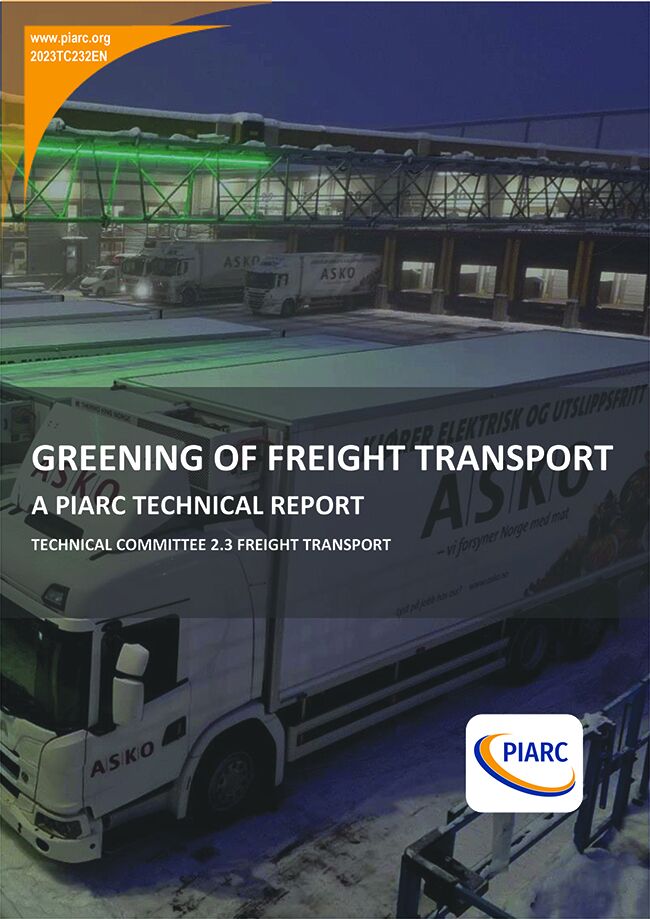Greening of Freight Transport - Technical Report

Global warming is a problem we experience every day including rising temperatures, rising water levels, and more frequent extreme weather events. As a major contributor to CO2 emissions, freight transport must also be a part of the solution. The purpose of this technical report is to highlight policies, initiatives, and projects that are utilized by PIARC member countries to reduce CO2 emissions from freight transport. Also, pollution and noise are important issues, especially in urban areas. These challenges might benefit from measures for cutting CO2 emissions. UN’s sustainable development goals include these areas, as well as the need for mobility and economic growth.
To achieve the 2023 climate target, major changes to the truck fleet must take place during the 2020’s. Countries, regions, states, and cities need plans, strategies, and programs for greening of freight transport. The European Green Deal and Fit for 55, and the US Inflation Reduction Act of 2022 are examples of actions steering a whole continent towards carbon neutrality, including emissions trading system, ban on sales of internal combustion engine (diesel and petrol), development of infrastructure for alternative fuels, and bonus instruments. In addition to plans, strategies, and programs for greening, we distinguish four approaches to reduce greenhouse gas emissions:
Lessons learned: Freight transport is key to our modern way of living, and our economic model is based on transport dependent trade. When green solutions are also economically best for the decision maker, implementation goes faster. The different transport modes’ shares of traffic volume are quite stable over time. Over the last decades, the challenge of changing the modal split is tenaciously great, which is not fully realized by everyone. Even through extreme circumstances, such as the Covid pandemic, the energy crisis and the war in Ukraine, road transport dominancy does not change substantially.
Targets to help shape policy: The most important responsibilities public authorities should shoulder are to set CO2 emission reduction targets, finance strategies, programs, and plans, secure knowledge, development, and regulations, initiate financing, and the necessary infrastructure, and spread the sense of urgency. Authorities can secure possibility and profitability for early movers by applying their purchasing power, regulatory authority, and infrastructural responsibilities. The possibilities within the traditional measures should be explored. Targets can conflict with each other. Authorities must choose wisely between the traditional broader measures that may slow the decrease of CO2 emissions or even increase them and more direct measures for fast reduction. Solutions for freight and passenger traffic might be considered together. It is more efficient to aim for results rather than for specific solutions, then possible.
Global warming will have tremendous negative impacts on many low and middle income countries due to their high dependence on natural resources and limited capacity to cope with the extreme effect of climate change. In addition, regions with more ambitious decarbonising policies may increase their competitiveness in the world market on behalf of regions with less ambitious policies, according to ITF forecasts. Increasing CO2 taxes and CO2 trading quotas are expected, as well as a customer demand for zero emission products and services. Two important questions are (1) what measures are most suitable for low and middle income countries as a starting point, and (2) if new technology will allow them to leapfrog to zero or low emission and effective solutions for road construction and freight transport.
Information sheet
- Date: 2023
- Author(s): Comité technique / Technical Committee / Comité Técnico 2020-2023 2.3 Transport de marchandises / Freight / Transporte de Mercancias
- Domain(s): Freight Transport
- Type: 2023R21EN - Technical report
- PIARC Ref.: 2023R21EN
- ISBN: 978-2-84060-794-6
- Number of pages: 102